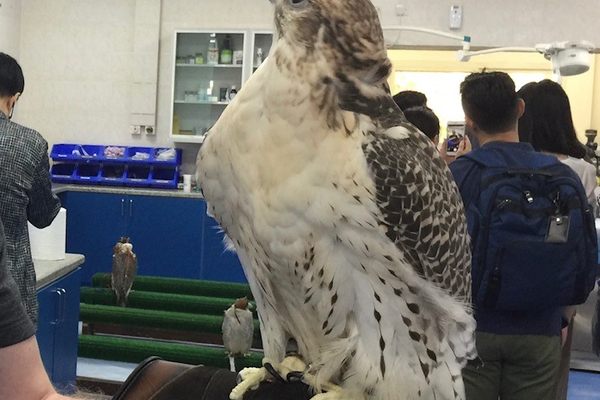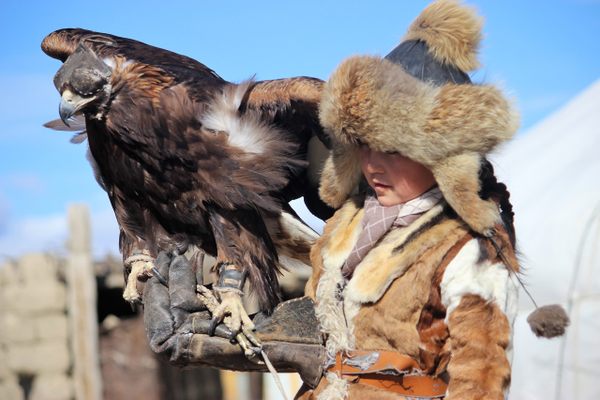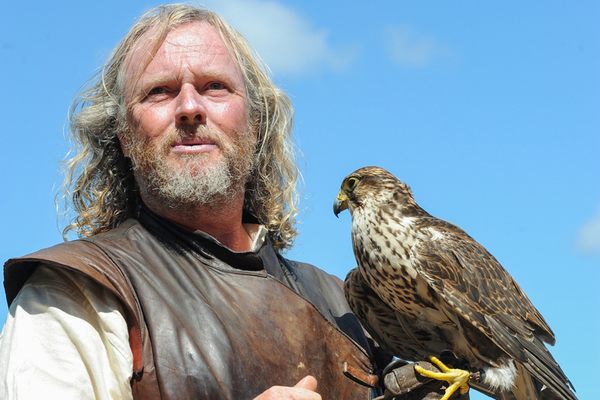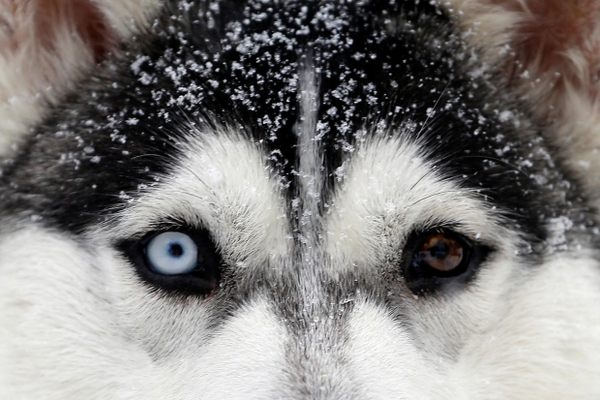
How the United Arab Emirates Became the Center of Falconry’s Gyre
And the hub of a world-spanning market for champion raptors.
This story is excerpted and adapted from Joshua Hammer’s The Falcon Thief: A True Tale of Adventure, Treachery, and the Hunt for the Perfect Bird.
In 1839, a 22-year-old aspiring diplomat and amateur archaeologist named Austen Henry Layard quit his job as a clerk in his uncle’s London law office and set out on what would become a decade-long journey across the Middle East. Arriving six years later at the Tigris River near Mosul in what is now Iraq, Layard excavated the ruins of Dur-Sharrukin, an Assyrian capital built between 720 and 700 B.C. There—amid temples emblazoned with cuneiform writings celebrating King Sargon II, the conqueror of Babylon, and giant statues of lamassus (winged creatures with the head of a man and body of a lion or a bull)—Layard unearthed a bas-relief that showed, he wrote, “a falconer bearing a hawk on his wrist.” The bearded hunter holds thin straps made of leather, known as jesses, or sbuq in Arabic, between his thumb and index finger, with the ends tied around the raptor’s feet. Layard’s discovery, the earliest known representation of falconry, made a strong case that the sport had originated in the Arab world at least 2,500 years before.
In its early days, long before the arrival of Islam in the Middle East, falconry served as a means of survival. Bedouins in the Arabian Desert trapped peregrines during the raptors’ autumn migration from Europe or Central Asia to Africa. The nomads trained the birds to kill and return to the gauntlet worn on their human’s fist, and to hunt hares or houbara bustards (large terrestrial birds) to supplement the Bedouins’ meager diet of milk and dates and rice. It was an efficient way of putting food on the table, and it established a unique relationship between man and bird. “For the Bedouin the [falcon’s] victory over its quarry was a feat of courage and strength in which they felt able to share,” wrote Mark Allen, a noted Arabist and the onetime director of MI6’s counterterrorism unit, in his 1980 book Falconry in Arabia. “In the [falcon’s] graceful restraint at rest and her grim hardness in the field, the Bedouin saw qualities which were for him among the criteria for honor in a tribal society.”

Arab traders likely introduced falconry to the West before the fall of the Roman Empire: In Eucharisticos, a confessional meditation written by the Macedonian Christian poet Paulinus of Pella in 458, the author recalls his adolescent wish to possess “a swift dog and a splendid hawk.” But in medieval Europe, falconry was practiced differently than in the early Bedouin hunts: training and housing birds of prey was beyond the means of most manor-bound peasants, and forests were the protected domains of the nobility, so “hawking,” as the sport also was known, became a leisure pursuit of monarchs and nobles, who organized lavish hunting parties on their estates. The aristocracy even established a pecking order, laid out in the Book of Saint Albans in 1486, for who could hunt with what. Only the king was entitled to a gyrfalcon, the world’s most exotic raptor, brought by traders from frozen Nordic cliffs. A prince could use a “falcon gentle,” or female peregrine, while a knight would have to make do with the slower but often equally agile saker. To a lady went a merlin, a small and sturdy falcon with a blocklike head. Lesser birds were designated for those common folk who did have the resources to hunt; these included the sparrow hawk for a priest, and the lowly kestrel for the “knave or servant” of a lord. Kings built elaborate mews on palace grounds, and lavished privileges on master falconers. The Laws of the Court under Hywel the Good, a 10th-century Welsh prince, stipulated that the royal falconer “is to have his horse in attendance, and his clothing three times in the year, his woolen clothing from the king, and his linen clothing from the queen, and his land free.”
During falconry’s boom times in the Middle Ages, relationships between Eastern and Western falconers flourished. In 1228 Frederick II of Hohenstaufen, the Holy Roman Emperor, hunted in the desert with Malik al-Kamil, the fourth Ayyubid sultan of Egypt, for three months during a lull in the Sixth Crusade. Twenty years later Emperor Frederick relied on the knowledge imparted to him by Syrian falconers whom he had brought back to Europe to write his classic work De Arte Venandi cum Avibus (On the Art of Hunting With Birds). By the 17th century, however, the proliferation of guns and, in England, the enclosure of land, rendered falconers an anachronism. No more than a few hundred falconers were left on the entire continent after the French Revolution and the Napoleonic Wars swept away the aristocracy.
And yet, as Austen Henry Layard made his way through the Tigris and Euphrates Valleys in 1845, he found that there, falconry was still appreciated as a form of art. In a caravansary (roadside inn) by the Euphrates, the archaeologist encountered Timour Mirza, an exiled Persian prince and the region’s most famed falconer. Reclining on carpets spread on a platform, Mirza “was surrounded by hawks of various kinds standing on perches fixed into the ground,” Layard wrote in his 1853 memoir Discoveries Among the Ruins of Nineveh and Babylon, “and by numerous attendants, each bearing a falcon on his wrist.” Layard noted the pageantry surrounding falconry and the esteem accorded the finest participants—and their birds. He admired such accoutrements as the raptor’s hood, which temporarily blinded the bird, protecting its delicate optic nerves from a blitz of sensations and soothing its high-strung disposition. The hood “is generally made of colored leather, with … gold and variegated thread,” Layard observed. “Tassels and ornaments are added, and the great chiefs frequently adorn a favourite bird with pearls and precious stones.”

The bird that had come to command the greatest respect among falconers was the shahin, or peregrine falcon, a term derived from the Middle Persian word šāhēn (literally “majestic” or “kingly”). “Although the smallest in size,” Layard explained to his readers, “it is esteemed for its courage and daring, and is constantly the theme of Persian verse.” This raptor “strikes its quarry in the air and may be taught to attack even the largest eagle, which it will boldly seize, and, checking its flight, fall with it to the ground.”
No consensus has ever been reached about the maximum speed of a peregrine as it stoops, or plummets, toward its prey. A BBC documentary pitted a peregrine named Lady against a free-falling skydiver equipped with a speedometer and a lure. The skydiver clocked in at 158 miles per hour. Lady, who hurtled past him, may have surpassed 180.
Perhaps the best accounts of falcons’ hunting behavior come from British writer J.A. Baker in his classic work The Peregrine. Baker, a nearsighted and arthritic clerk from Essex, tracked peregrines in the winter landscapes of his native East Anglia between 1954 and 1962. His observations are infused with a sense of the fragility of nature (the DDT poisonings were at their height), the beauty of the English countryside, and appreciation for the raptor’s grace in flight. But over and over he returns in his writings to the stoop and the kill. “The peregrine swoops down toward his prey,” he writes in The Peregrine. “As he descends, his legs are extended forward till the feet are underneath his breast … His extended toe … gashes into the back or breast of the bird, like a knife—If the prey is cleanly hit—and it’s usually hit hard or missed altogether—it dies at once, either from shock or from the perforation of some vital organ.” He describes with grisly admiration the raptor’s “tomial tooth”—a sharp projection on the upper mandible that lets the bird snap the vertebrae of any prey that isn’t killed instantly on the stoop. “The hawk breaks its neck with his bill, either while he is carrying it or immediately [when] he alights,” he observed. “No flesh-eating creature is more efficient, or more merciful, than the peregrine.”

To accomplish that—to target and then dive-bomb a wood pigeon or a grouse from 5,000 feet at nearly 200 miles an hour, and strike it dead with a single swipe of the foot—requires extraordinary physical abilities. The bird’s large, well-developed chest muscles, connected to a broad breastbone and nourished by oxygen drawn in continuously by nine air sacs throughout the body, power its wings through high-speed flight. This hyperefficient respiratory and circulatory system also keeps the air flowing and the blood pumping as the peregrine descends at velocities that would render any other species unconscious. Light and hollow bones, long and stiff flight feathers, and streamlined wings keep air resistance to a minimum, while the extra-wide tail base supports powerful musculature to turn and brake while in hot pursuit. All this allows the bird to maximize its speed and flexibility. The bird’s optic nerves, meanwhile, relay images to its brain 10 times faster than those of a human, “so events in time that we perceive as a blur,” Helen Macdonald, best known for her memoir H Is for Hawk, noted in an earlier study, Falcon, “like a dragonfly zipping past our eyes, are much slower to them.”
Above all, peregrine falcons perceive the world with a vividness and depth that human beings can hardly appreciate. Photoreceptor cells cram into the falcon’s fovea, the tiny pit located in the retina that handles the most important visual tasks. A human has about 30,000 color-sensitive cones in the retina; a falcon has one million. With two foveae in each eye, one for depth and one for lateral perception, the falcon’s eye functions simultaneously as both a macro lens and a zoom lens. Falcons can also perceive ultraviolet light, making colors stand out even more vividly and enabling the falcon to identify the shape and texture of plumage from as far as a mile away. Macdonald quoted Andy Bennett, a researcher in the field of avian vision, as saying that the difference between the eyesight of a human and that of a falcon is like the difference “between black-and-white and color television.”

On October 16, 1931, south of the desert mountain known as Jebel Dukhan (Mountain of Smoke) in the island kingdom of Bahrain, the first oil spouted from a well drilled by the Bahrain Petroleum Company, a firm established two years earlier by Standard Oil of California. The well, which was soon pumping 9,600 barrels a day, was the first to produce oil on the Arabian side of the Persian Gulf. Others quickly followed—in Qatar in 1935, Saudi Arabia and Kuwait in 1938, Abu Dhabi in 1958, and Oman in 1964.
The flood of petrodollars over the next decades turned Gulf societies upside down. The oil industry covered vast swaths of desert with wells, pipelines, refineries, access roads, and other infrastructure, creating a new urban population and erasing much of Bedouin society. Yet despite the upheaval, falconry remains fundamental to the culture of that part of the world. Falcons appear on corporate logos, banknotes, and the national emblem of the United Arab Emirates, a federation of seven Gulf sheikhdoms, the largest of which are Abu Dhabi and Dubai. The most extravagant new real estate project in Dubai is “Falconcity of Wonders,” a 107-square-mile conglomeration of opulent hotels and residences, all laid out in the shape of a peregrine. And the sheikhs there have managed to retain fragments of a mostly vanished way of life. Wealthy falconers stock private reserves with prey such as captive-bred houbara bustards—having hunted the wild ones out of existence decades ago—and pack their falcons onto 747s and fly to leased hunting grounds in Central Asia and North Africa.
In 2002, Sheikh Hamdan bin Mohammed bin Rashid Al Maktoum, son and heir of Sheikh Mohammed bin Rashid Al Maktoum, the billionaire ruler of Dubai, introduced a new sport to the Arab world: falcon racing. While the crown prince had the luxury of hawking in his own private hunting grounds and on royal expeditions, he recognized that such opportunities were out of reach for the average Gulf citizen. Racing was Sheikh Hamdan’s ambitious attempt to keep Emiratis connected to their heritage. The populist move also turned falconry into a multimillion-dollar global enterprise.

At the first falcon race organized by the crown prince in January 2002, several thousand participants—ranging from royal family members with an aviary full of falcons to ordinary citizens with a single bird—gathered beside a field of sand in Dubai to time their birds with stopwatches over a 400-meter course. The falcons flew sequentially, to avoid catastrophic midair collisions, coaxed into action by a man positioned at the far end of the field swinging a telwah—a lure fashioned from a pair of bustard wings. A younger brother of Dubai’s ruler trounced all other competitors with a peregrine that flew the course in 16 seconds, or 50 miles an hour.
The races quickly caught on—and spawned a cottage industry. Royal families dispatched high-paid agents to purchase promising racers from breeders domestically and abroad, and set up desert training grounds where elite coaches could teach their falcons to fly in straight lines and stay low to the ground, even using light aircraft to drag feathered lures ahead of the birds at high speeds. Dieticians maintained the birds at racing weight, while veterinarians kept their feathers in perfect condition; a frayed or broken quill could be a significant disadvantage in a sport where a few tenths of a second can separate the top contestants in a heat. A champion falcon can compete for only three or four years before losing its edge, at which point the best are often retired to stud. (Rumors have persisted, but have never been proven, that older falcons are destroyed once they’ve passed their racing prime.) One of the greatest studs in racing history, Fast Lad, a 16-year-old gyrfalcon owned by Bryn Close—a breeder in Northern England for various Emirati royal families—has sired hundreds of winners in a dozen years.
Five years after bringing racing to Dubai, Crown Prince Hamdan introduced the Fazza (“Victory”) Championships, a two-week competition with $8 million in prizes provided by his family. An Italian-designed system of laser beams that sensed exactly when a peregrine crossed the starting and finish lines ensured precision timing to the hundredth of a second. The crown prince created separate racing categories for sheikhs, professional falconers, and the public, with distinct heats for juvenile and adult birds, hybrids and purebreds, and males and females. In 2014 Sheikh Khalifa bin Zayed Al Nahyan, the ruler of Abu Dhabi and the fourth wealthiest monarch in the world, with a fortune estimated at $15 billion, created a tournament with even greater rewards. The President Cup, held each January at the Abu Dhabi Falconers Club and paid for by the Al Nahyan clan, offers a purse of $11 million. The prizes include 60 Nissan Patrol SUVs, dozens of cash awards of up to 25,000 dirhams ($6,800), and—most important to status-obsessed royals—engraved golden trophies for the winners in the six championship events.

The President Cup is an exquisitely organized affair. In the huge spectators’ tent at the edge of the desert racecourse, sheikhs and their entourages, draped in white gowns and keffiyehs, relax on ornate sofas and wing chairs, plucking grapes, apples, and oranges from porcelain bowls while observing the races through floor-to-ceiling windows or on closed-circuit television screens. Boys in white turbans circulate among the guests—mostly Emiratis, but also breeders from across the globe—pouring shots of bitter Arabic coffee from brass urns into white ceramic cups. Dozens of hooded falcons of different hues and sizes wait on wooden perches to be carried down a red carpet one by one to the starting gate, where an announcer whips up excitement with vehement exhortations and pleas to God. Dehooded and released from the trainer’s wrist at a signal, most falcons hug the ground and fly on a straight trajectory across the 400-meter-long field, but a few rise up as if preparing for the stoop, and, when I visited the President Cup in January 2018, one gyrfalcon belonging to Sheikh Mohammed, the ruler of Dubai, veered off toward a distant line of sand dunes, to the dismay of her supporters, before finding her way back to the course. She crossed the finish line with a time four seconds slower than the next-to-last bird.
The competition between the Al Maktoum and the Al Nahyan families, and to a lesser extent the ruling clans of other Gulf States, has fueled a quest for the fastest, hardiest, and most beautiful falcons in the world. The falcon market was “on a downward spiral before the races— breeders all around the world were struggling,” Zimbabwean breeder Howard Waller told Arabian Business for a 2015 article entitled “Sheikh Hamdan’s Bid to Revive the Glorious Arab Sport of Falconry.” Now, he said, “it’s become an international business opportunity—everybody’s trying to get in.” Waller quoted the top price for a captive-bred female peregrine from the United Kingdom as £70,000, up from just £1,500 a few years earlier. In 2013 a pure white gyrfalcon, the largest and most powerful species of the Falconidae family, had been sold to a royal in Doha, the capital of Qatar, for 1,000,000 dirhams, or $272,000, “drawing gasps from breeders,” according to the magazine. Crown Prince Hamdan matched that price four years later, a well-placed source in Abu Dhabi told me, for a captive-bred gyrfalcon-peregrine hybrid that had just swept to victory in four consecutive races in the President Cup. “Any strong falcon the Crown Prince hears about he buys,” the source said. “For him, it is all about prestige.”

By the 20th century, Europeans had come to revile peregrines as pests and vermin. In June 1940 Great Britain’s Air Ministry declared the peregrine a menace to the carrier pigeons that Royal Air Force pilots were releasing from cockpits to dispatch messages to contacts in Nazi-occupied Europe. The government authorized the shooting of hundreds of adult and juvenile birds and the killing of thousands of chicks and eggs in the nests.
The environmental consciousness that spread across Europe and the United States in the 1960s and 1970s helped revive an appreciation for birds of prey. These days some 5,000 Americans and 25,000 Britons participate in falconry, triple the number from five decades ago. The birders range from urban enthusiasts such as Helen Macdonald, who trained a goshawk named Mabel in her home in Cambridge, to wealthy landowners who stage hunts on horseback each summer in the Northumberland countryside. One English writer called the revival a “back-to-nature quest,” stemming from “a postindustrial society’s hunger to reconnect with ancient traditions.”
Near the Welsh village of Carmarthen, an English biologist, sportsman, and entrepreneur named Nick Fox has bred falcons for 30 years for Sheikh Mohammed bin Rashid Al Maktoum, the ruler of Dubai, an Anglophile who first traveled to the United Kingdom in 1966 to study English in Cambridge. In recent years Fox has been joined by other registered breeders in the United Kingdom, Ireland, France, Spain, Germany, the United States, and South Africa who now compete for shares of the fantastically lucrative Arab market; today, the majority of the 12,000 captive-bred raptors exported from the West are destined for the United Arab Emirates. Fox also sells the richest Arabs a falconry flight-training device called the Robara, a remote-controlled machine, shaped like a houbara bustard, that can match the cruising speeds of falcons and act as the bait. In Dubai a venture partly owned by the Al Maktoum family takes Western tourists in hot-air balloons over the Arabian Desert to watch trained falcons fly and dive at 5,000 feet.

This money-fueled globalization also has an underside: a thriving black market for wild birds of prey, driven by wealthy Middle Eastern enthusiasts who believe that falcons stolen from nests are superior to those bred in captivity, and who are willing to break the law to get them. Investigations by conservation groups and information provided by commercial breeders had disclosed that the richest aficionados were spending huge sums, up to $400,000 for a single bird, to acquire raptors from the wild. The thieves used pigeons and other lures to take fledglings in mid-flight, or, on occasion, scaled cliffs and trees and seized chicks from nests.
Expensive paramilitary-style expeditions to the Kamchatka Peninsula, Siberia, Mongolia, the Indian subcontinent, Greenland, Patagonia, and other wildernesses were said to be disturbing the ecological balance of pristine regions by threatening the survival of the world’s most endangered species. In the first two decades since the collapse of the Soviet Union, for example, raptor “trappers” had nearly wiped out saker falcons—a migratory species, slower than the peregrine, that breeds from Central Europe across Asia to Manchuria. Mark Jeter, a former assistant chief of the California Department of Fish and Wildlife, described the black market trade succinctly: “I always say, if there is a $50,000 bill lying around, someone is going to try to catch it.”
Then, in May 2010, a man named Jeffrey Lendrum attempted to pull off an ingenious variation of this scheme. British Counter Terrorism agents, alerted by a suspicious janitor, detained Lendrum while he waited in the business class lounge at Birmingham Airport to board a flight to Dubai. They strip-searched him, and discovered that he was carrying, taped to his body, 14 live peregrine falcon eggs stolen from cliffs in southern Wales and apparently destined for hunters and racers in the United Arab Emirates. Smugglers, the police quickly realized, could be running eggs between Europe and the Arab world in a far-reaching conspiracy to defy international wildlife laws and damage the environment, financed by some of the richest and most powerful men on Earth.
The story of Lendrum and the detective who tracked him continues in The Falcon Thief: A True Tale of Adventure, Treachery, and the Hunt for the Perfect Bird.






















Follow us on Twitter to get the latest on the world's hidden wonders.
Like us on Facebook to get the latest on the world's hidden wonders.
Follow us on Twitter Like us on Facebook